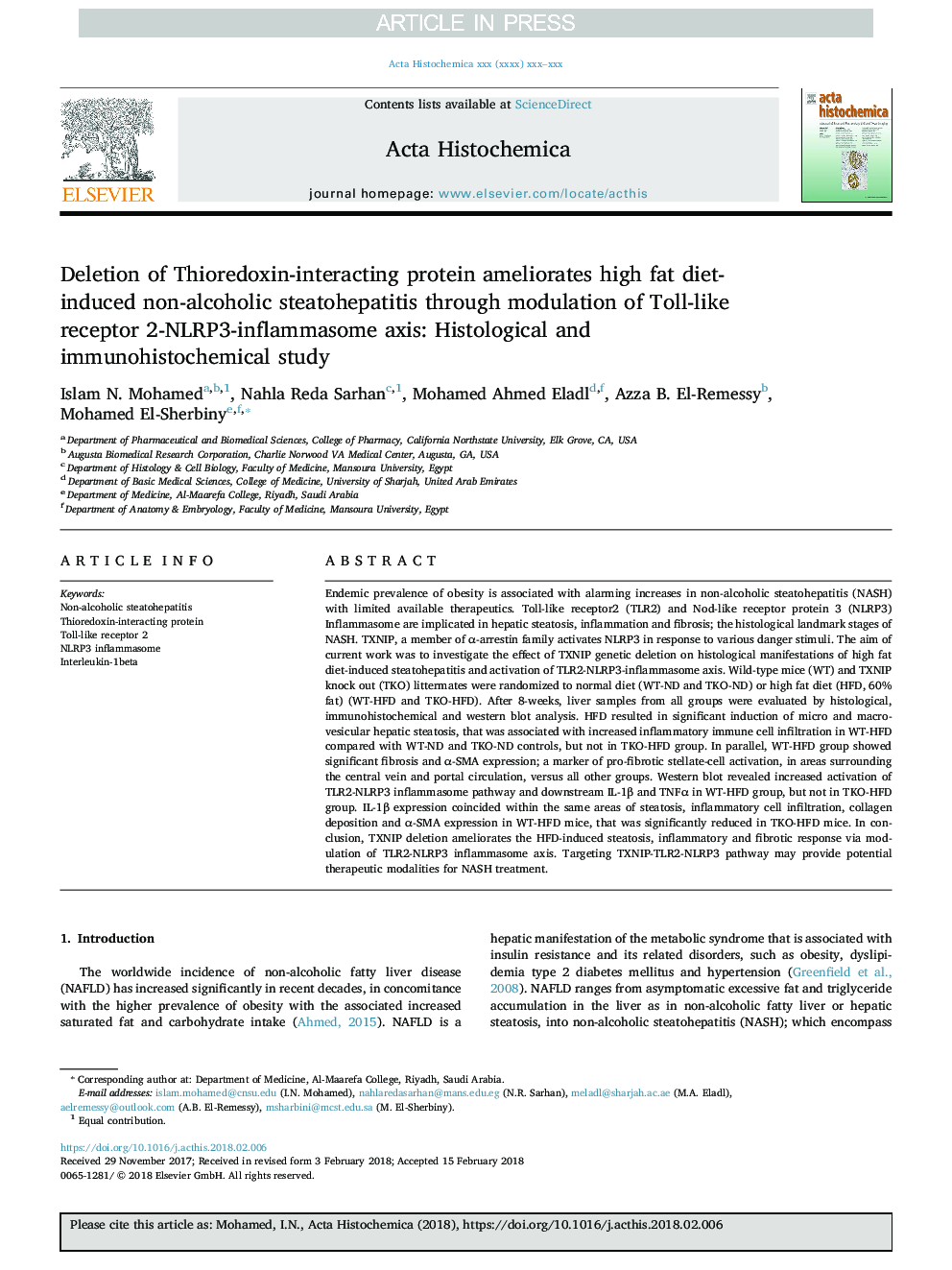| کد مقاله | کد نشریه | سال انتشار | مقاله انگلیسی | نسخه تمام متن |
|---|---|---|---|---|
| 8287532 | 1535856 | 2018 | 13 صفحه PDF | دانلود رایگان |
عنوان انگلیسی مقاله ISI
Deletion of Thioredoxin-interacting protein ameliorates high fat diet-induced non-alcoholic steatohepatitis through modulation of Toll-like receptor 2-NLRP3-inflammasome axis: Histological and immunohistochemical study
دانلود مقاله + سفارش ترجمه
دانلود مقاله ISI انگلیسی
رایگان برای ایرانیان
کلمات کلیدی
موضوعات مرتبط
علوم زیستی و بیوفناوری
بیوشیمی، ژنتیک و زیست شناسی مولکولی
زیست شیمی
پیش نمایش صفحه اول مقاله

چکیده انگلیسی
Endemic prevalence of obesity is associated with alarming increases in non-alcoholic steatohepatitis (NASH) with limited available therapeutics. Toll-like receptor2 (TLR2) and Nod-like receptor protein 3 (NLRP3) Inflammasome are implicated in hepatic steatosis, inflammation and fibrosis; the histological landmark stages of NASH. TXNIP, a member of α-arrestin family activates NLRP3 in response to various danger stimuli. The aim of current work was to investigate the effect of TXNIP genetic deletion on histological manifestations of high fat diet-induced steatohepatitis and activation of TLR2-NLRP3-inflammasome axis. Wild-type mice (WT) and TXNIP knock out (TKO) littermates were randomized to normal diet (WT-ND and TKO-ND) or high fat diet (HFD, 60% fat) (WT-HFD and TKO-HFD). After 8-weeks, liver samples from all groups were evaluated by histological, immunohistochemical and western blot analysis. HFD resulted in significant induction of micro and macrovesicular hepatic steatosis, that was associated with increased inflammatory immune cell infiltration in WT-HFD compared with WT-ND and TKO-ND controls, but not in TKO-HFD group. In parallel, WT-HFD group showed significant fibrosis and α-SMA expression; a marker of pro-fibrotic stellate-cell activation, in areas surrounding the central vein and portal circulation, versus all other groups. Western blot revealed increased activation of TLR2-NLRP3 inflammasome pathway and downstream IL-1β and TNFα in WT-HFD group, but not in TKO-HFD group. IL-1β expression coincided within the same areas of steatosis, inflammatory cell infiltration, collagen deposition and α-SMA expression in WT-HFD mice, that was significantly reduced in TKO-HFD mice. In conclusion, TXNIP deletion ameliorates the HFD-induced steatosis, inflammatory and fibrotic response via modulation of TLR2-NLRP3 inflammasome axis. Targeting TXNIP-TLR2-NLRP3 pathway may provide potential therapeutic modalities for NASH treatment.
ناشر
Database: Elsevier - ScienceDirect (ساینس دایرکت)
Journal: Acta Histochemica - Volume 120, Issue 3, April 2018, Pages 242-254
Journal: Acta Histochemica - Volume 120, Issue 3, April 2018, Pages 242-254
نویسندگان
Islam N. Mohamed, Nahla Reda Sarhan, Mohamed Ahmed Eladl, Azza B. El-Remessy, Mohamed El-Sherbiny,